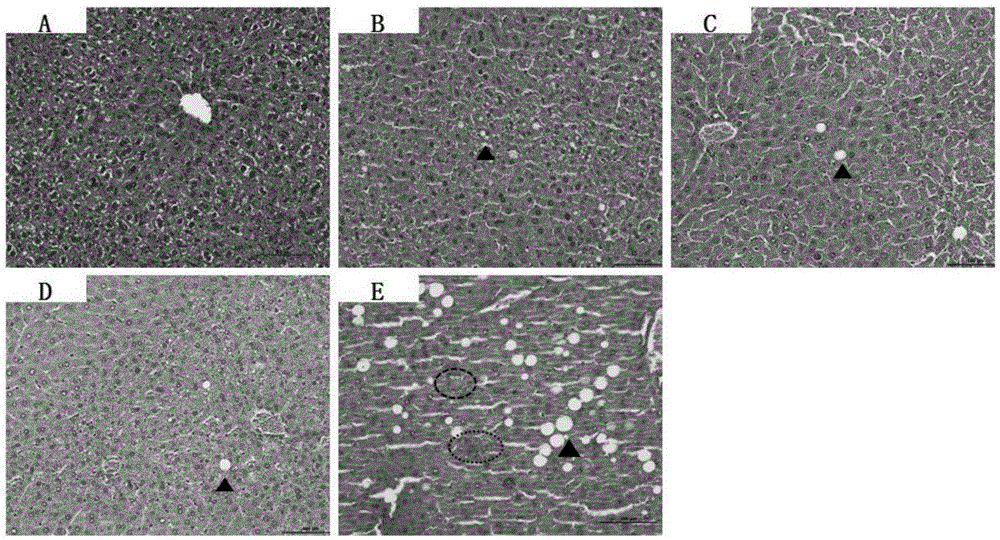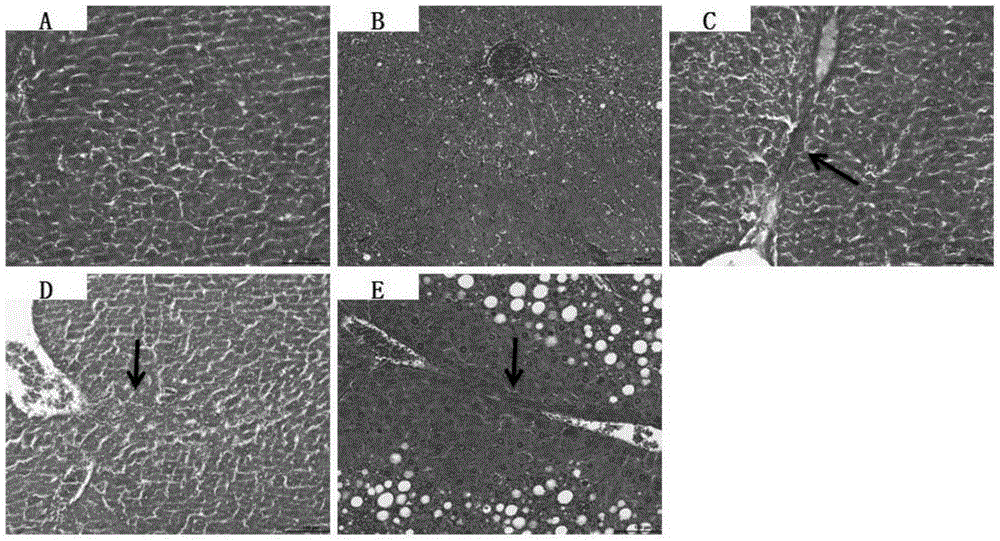Feed for preparation of alcoholic liver animal model
An alcoholic liver disease and animal model technology is applied in the field of feed for preparing alcoholic liver disease animal models. High mold success rate, easy to popularize and apply
- Summary
- Abstract
- Description
- Claims
- Application Information
AI Technical Summary
Problems solved by technology
Method used
Image
Examples
Embodiment 1
[0061]A kind of feed that is used to prepare animal model of alcoholic liver disease, taking preparation 1L described feed as example, its preparation method is as follows:
[0062] 1) 41.4 grams of casein, 0.5 grams of L-cystine, 0.3 grams of DL-methionine, 10 grams of dietary cellulose, 3.0 grams of xanthan gum, 0.53 grams of choline bitartrate, 8.75 grams of mineral premix, vitamin Add 2.5 grams of premix, 2.0 grams of cholesterol and 0.2 grams of sodium cholate into a container, then add an appropriate amount of water, and stir evenly to obtain mixture A;
[0063] 2) Add 12.8-25.6 grams of maltodextrin into another container, then add an appropriate amount of water, stir evenly, add it to mixture A, stir evenly, bottle it, seal it, and store it at 4°C for later use.
[0064] 3) Add 30-40 grams of fish oil and 25-50 grams of alcohol (alcohol is measured by ethanol, and the specific form of alcohol is liquor) into the bottle of step 2), and stir evenly to obtain 1 L of feed ...
Embodiment 2
[0066] A kind of feed that is used to prepare animal model of alcoholic liver disease, taking preparation 1L described feed as example, its preparation method is as follows:
[0067] 1) 41.4 grams of casein, 0.5 grams of L-cystine, 0.3 grams of DL-methionine, 10 grams of dietary cellulose (Roquette water-soluble dietary fiber, French Roquette), 3.0 grams of xanthan gum, and heavy tartaric acid Choline 0.53 g, Mineral Premix (Dyets.Inc#210011) 8.75 g, Vitamin Premix (Dyets.Inc#310011) ( http: / / dyets.com / vitamin-mixes / ) 2.5 grams, 2.0 grams of cholesterol and 0.2 grams of sodium cholate were added to the container, then an appropriate amount of water was added, and the mixture was evenly stirred to obtain mixture A;
[0068] 2) Add 25.6 g of maltodextrin into another container, then add an appropriate amount of water, stir evenly, add it to mixture A, stir evenly, bottle it, seal it, and store it at 4°C for later use.
[0069] 3) Add 36g fish oil (DSM#MEG-3, containing 12%-13...
Embodiment 3
[0071] Example 3 Preparation of Alcoholic Liver Disease Animal Model
[0072] Male Kunming mice were divided into 2 groups: 15 Kunming mice in the model group and 6 Kunming mice in the pair-feeding group. Each mouse was reared in a single cage, and the feed prepared in Example 2 was freely eaten every day. The feed for mice in the pair-feeding group was formulated with maltodextrin instead of alcohol in the above-mentioned feed. From the second week of feeding, the model group was given alcohol once every 5-7 days (56°Red Star Erguotou, supervised by Beijing Red Star Co., Ltd.), the initial dose was 4g / kg, and then gradually increased to 5g / kg each time. kg, 6g / kg, 6g / kg. After the fourth gavage, a liver was selected from an animal, fixed in 10% formalin, stained by H&E and Masson, and observed histopathologically.
[0073] Wherein, the gavage dosage of alcohol is all measured with ethanol, the following examples are the same.
PUM
 Login to View More
Login to View More Abstract
Description
Claims
Application Information
 Login to View More
Login to View More - R&D
- Intellectual Property
- Life Sciences
- Materials
- Tech Scout
- Unparalleled Data Quality
- Higher Quality Content
- 60% Fewer Hallucinations
Browse by: Latest US Patents, China's latest patents, Technical Efficacy Thesaurus, Application Domain, Technology Topic, Popular Technical Reports.
© 2025 PatSnap. All rights reserved.Legal|Privacy policy|Modern Slavery Act Transparency Statement|Sitemap|About US| Contact US: help@patsnap.com


